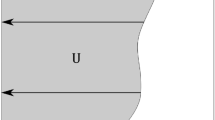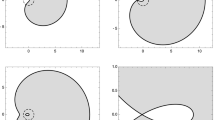Abstract
For a Brownian motion moving on a pseudo sphere in Minkowski space \(\mathbb {R}^l_v\) of radius r starting from point X, we obtain the distribution of hitting a fixed point on this pseudo sphere with \(l\ge 3\) by solving Dirichlet problems. The proof is based on the method of separation of variables and the orthogonality of trigonometric functions and Gegenbauer polynomials.


Similar content being viewed by others
References
Cohen de Lara, M.: On drift, diffusion and geometry. J. Geom. Phys. 56(8), 1215–1234 (2006)
Cammarota, V., De Gregorio, A., Macci, C.: On the asymptotic behavior of the hyperbolic Brownian. J. Stat. Phys. 154(6), 1550–1568 (2013)
Cammarota, V., Orsingher, E.: Hitting spheres on hyperbolic spaces. Theory Probab. Appl. 57(3), 419–443 (2013)
Dunkel, J., Hänggi, P.: Relativistic Brownian motion. Phys. Rep. 471(1), 1–73 (2009)
Dembo, A., Peres, Y., Rosen, J.: Brownian motion on compact manifolds: cover time and late points. Electron. J. Probab. 8(15), 1–14 (2003)
Dembo, A., Peres, Y., Rosen, J., Zeitouni, O.: Cover times for Brownian motion and random walks in two dimensions. Ann. Math. 160(2), 433–464 (2004)
Grigor’yan, A.: Analytic and geometric background of recurrence and non-explosion of the Brownian motion on Riemannian manifolds. Bull. Am. Math. Soc. 36, 135–249 (1999)
Garbaczewski, P.: Rotational diffusions as seen by relativistic observers. J. Math. Phys. 33(10), 3393–3401 (1992)
Gradshteyn, I.S., Ryzhik, I.M.: Table of Integrals, Series, and Products, 4th edn. Academic Press, New York (1981)
Itô, K.: On stochastic differential equations on a differential manifold I. Nagoya Math. J. 1, 35–47 (1950)
Lablée, O.: Spectrual Theory in Riemannian Geometry. European Mathematical Society (EMS), Zurich (2015)
Morava, J.: Conformal invariants of Minkowski space. Proc. Am. Math. Soc. 95, 565–570 (1985)
Mckean, H.P.: Stochastic Integrals. Academic Press, New York (1969)
Mizrahi, S., Daboul, J.: Squeezed states, generalized Hermitz polynomials and pseudo-diffusion equation. Phys. A 189, 635–650 (1992)
Øksendal, B.: Stochastic Differential Equations, an Introduction with Applications, 6th edn. Springer, New York (2003)
O’Hara, P., Rondoni, L.: Brownian motion in Minkowski space. Entropy 17, 3581–3594 (2015)
O’neill, B.: Semi-Riemannian Geometry with Applications to Relativity. Academic Press, New York (1983)
Polyanin, A.D., Zaitsev, V.F.: Handbook of Exact Solution for Ordinary Differential Equations. Chapman & Hall, Boca Raton (2003)
Szegö, G.: Orthogonal Polynomials, 4th edn. AMS, Providence (1975)
Acknowledgments
We thank the anonymous referees for their valuable suggestions and comments.
Author information
Authors and Affiliations
Corresponding author
Additional information
This work was supported by National Basic Research Program of China (Grant No. 2013CB834100), National Natural Science Foundation of China (Grant No. 11571065), and National Natural Science Foundation of China (Grant No. 11171132). Xiaomeng Jiang is supported by a foundation. The foundation number is National Natural Science Foundations of China (Grant No. 11301541).
Appendix: Calculations of the Laplacian–Beltrami Operator
Appendix: Calculations of the Laplacian–Beltrami Operator
This appendix is devoted to the calculations of the Laplacian–Beltrami operator restricted on pseudo spheres. First, we consider Laplacian–Beltrami operator restricted on a spacelike pseudo sphere of \(\mathbb {R}^3_1\), namely, on the spacelike pseudo sphere
under the relationship given by
or
Thanks to multivariable calculus, we have the expression of \(\Delta \) restricted on \(\mathbb {S}^{3,1}\). That is,
To calculate the Laplacian \(\Delta \) in spacelike coordinates, we only need to calculate the partial differentials on the right hand side of equality (4.66). By (4.65), we get
Thus, the coefficients in the partial differential operators in (4.66) are
while the coefficients of the cross terms are zeros.
Then the Laplacian–Beltrami operator \(\Delta \) restricted on \(\mathbb {S}^{3,1}\) can be expressed in coordinates \((\eta ,\alpha ,\beta )_{\mathbb {S}}\) as
while the Laplacian–Beltrami operator restricted on \(\mathbb {S}^{3,1}_r\) is expressed as
Now return to the general case \(\mathbb {R}^l_v\). Letting \(x=(x_1,x_2,\ldots ,x_v)\) and \(y=(y_1,y_2,\ldots ,y_{l-v})\), for any point \(X\in \mathbb {S}^{l,v}\) we have
Again, we use the coordinates similar to \((\cdot ,\cdot ,\cdot )_{\mathbb {S}}\), namely, a system of coordinates \((\eta ,\alpha ,\theta _y,\theta _x)_{\mathbb {S}}\) satisfying
and \(\theta _x=(\theta _{x,1},\ldots ,\theta _{x,v-1})\), \(\theta _y=(\theta _{y,1},\ldots ,\theta _{y,l-v-1})\) are the standard polar coordinates on the Euclidean unit sphere \(\mathcal {S}^{v-1}\) and \(\mathcal {S}^{l-v-1}\) respectively. Thus the Laplacian–Beltrami operator restricted on \(\mathbb {S}^{l,v}\) with \(l\ge 4\) can be expressed as
where \(\Delta _{\mathcal {S}^n}\) is the Laplacian operator on the n-dimensional unit sphere.
Rights and permissions
About this article
Cite this article
Jiang, X., Li, Y. Brownian Motion on a Pseudo Sphere in Minkowski Space \(\mathbb {R}^l_v\) . J Stat Phys 165, 164–183 (2016). https://doi.org/10.1007/s10955-016-1574-0
Received:
Accepted:
Published:
Issue Date:
DOI: https://doi.org/10.1007/s10955-016-1574-0




